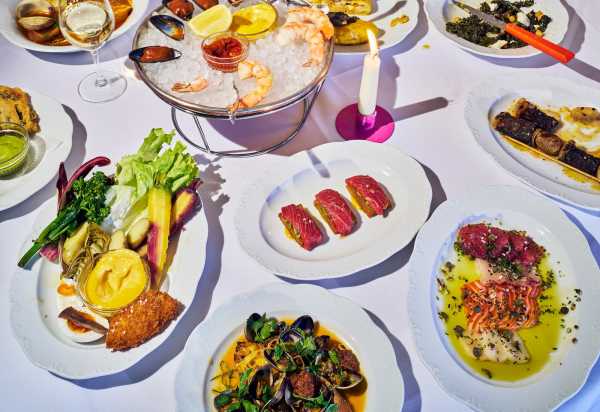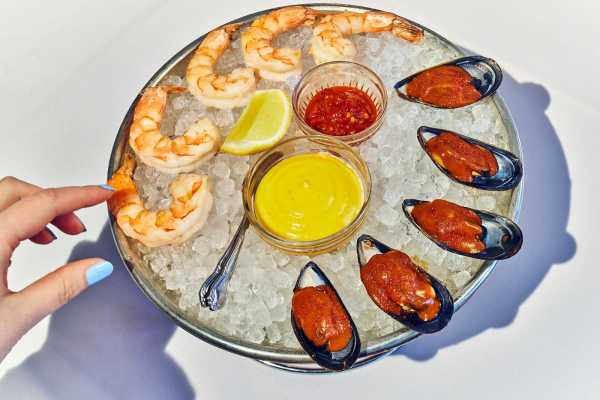
Save this storySave this storySave this storySave this storyYou’re reading the Food Scene newsletter, Helen Rosner’s guide to what, where, and how to eat. Sign up to receive it in your inbox.
One of the more pleasing trends these days in New York dining is the casually perfectionistic seafood restaurant. There’s Penny, exuding a marble-wrapped friendliness; Quique Crudo, in the West Village, teensy and glimmering; Strange Delight, bringing a Cajun playfulness to Brooklyn’s Fort Greene; and the excellent and often wonderfully weird Smithereens, in the East Village. I suppose, yes, on a certain level, a chilled shrimp is a chilled shrimp is a chilled shrimp, but there’s novelty, even thrill, to be found in the details: the size and shape and arrangement, the specifics of the saucing, the hint of bay leaf or juniper from the court bouillon. At Crevette, a new spot in the West Village, the chilled shrimp are pink and sweet and slightly coquettish, served with a gracious aioli and bowl of minced Calabrian chile that nods to cocktail sauce but skews more Mediterranean, more feminine, more knowing. The restaurant doesn’t so much enter the seafood conversation as elegantly commandeer it. Crevette is yet another spot to get squid and beans, but, oh, what squid and beans they are!
Crevette is the third restaurant from Patricia Howard and the London-born chef Ed Szymanski, whose previous ventures, Dame and Lord’s, established them as the kind of restaurateurs who can transform straightforward briefs (English fish and chips; English gastropub fare) into something at once rigorously referential and creatively their own. At Crevette, they’ve turned their gaze beyond Britain to assorted nearby coastlines: that thrilling swoop at the southeastern corner of the Bay of Biscay that runs from San Sebastián up to Biarritz, the lush sweep of the Cote d’Azur, the sunny arc of the Ligurian Sea. (“Crevette” is how you say “shrimp” en francais.) The space, which was previously home to the gently appalling chrome-and-leather influencer magnet Holiday Bar, has been evocatively re-outfitted in creamy whites, honey-toned wood, and the off-pastel tones of a ritzy beach club—sherbet yellow, seashell pink, melon orange, cerulean blue. A tucked-away, slightly elevated bar area seems to exist primarily for eating rather than drinking (and provides one of the neighborhood’s loveliest perches for a solo dinner); scalloped banquettes feel intimate and a little sexy. The effect is that of a restaurant that doesn’t so much thematically re-create a regional aesthetic as capture an ambient sensibility, a certain quality of light.

The menu includes a “petit aioli” (left), mussels, and assorted crudos and raw fish.
As with the chilled shrimp, the food follows a principle of easygoing elegance. A puck of Spanish tortilla is a textural feat, with tender bits of potato suspended in a vividly yellow matrix of egg that’s still slightly soft at its center; a snowcap of sweet peekytoe crab dressed in a richly saline seaweed butter adds silk on top of silk. Seafood rice with saffron, razor clams, and lobster sits somewhere in the genetic lineage of paella and related arroz con cosas, each grain plump and springy, slick with aromatic fats, harmonizing with the quiet assertiveness of the shellfish. The airy, crispy fritto misto, like the fish and chips at Dame, proves that Szymanski is one of the city’s foremost practitioners of the sacred art of deep-frying.
The petit aioli (a winking little riff on the Provençal grand aioli) is a controlled study in abundance. A bowl of the eponymous garlicky sauce, tinted rich yellow with egg yolks and golden olive oil, is surrounded by a seasonally changing lineup of vegetables that included, on my visits, a salade Niçoise-ish array of multicolored carrots, tender tiny potatoes, baby artichoke hearts, and two varieties of radicchio. The composition is completed by a halved soft-boiled egg, each face draped with a cured anchovy, and a pair of panko-crusted fried skate cheeks, whose texture suggests something between scallop and halibut—a slight sweetness, a tender give. I was struck by the attention to detail: the carrots are par-cooked, for ease of chomping; the chicories delicately salted leaf by leaf. It’s the sort of dish that makes a person lament that Crevette is open only for dinner; paired with a diminutive Martini (the Montgomery, scented with orange bitters, is a wee two-and-a-half ounces and served in a chic little bistro-style water glass), the petit aioli would make the perfect solo lunch for the sort of afternoon when you want to feel like a character in a novel in translation, languidly alone, with nowhere particular to be. There’s a note-perfect bouillabaisse, that storied fisherman’s stew that began as a utilitarian way to use up the unsellable bycatch before evolving into one of the world’s great soups. Crevette’s version is rapturous: a russet-colored broth, perfumed with saffron and fennel, in which swim tender hunks of John Dory, monkfish, black bass, and red mullet. Stir in the rouille—a saffron-kissed mayonnaise—to enrich the already opulent broth, and let the croutons soften until they’re suspended somewhere between crispiness and collapse.

Poached pink shrimp and chilled mussels with salsa brava.
Not everything at Crevette is effortless perfection. The Dover sole, a pricey fish that seems to be experiencing a renaissance in New York’s more high-end dining rooms, arrives traditionally dressed in capers and béarnaise, the body de-finned and de-tailed, but otherwise intact. A server gave a brief set of verbal instructions for D.I.Y. filleting, and then disappeared, leaving us to it. Dover sole is one of the easier fish to take apart, but the task nevertheless requires both skill and confidence, of which I have only the latter; luckily, I was dining with a friend in possession of both, but his dexterous manipulations somewhat anticlimactically revealed an underdone interior. I wonder if the restaurant might be better served doing the knife work themselves, offstage; then again, the pared-down presentation would feel at odds with the restaurant’s whole vibe of gentleman-fisherman exuberance. But that’s a minor quibble about a kitchen that otherwise exudes competence. The seafood-averse would be remiss to overlook the chicken, a handsome presentation of a deboned half bird rubbed with spices that give the skin a dark, burnished oxblood hue. Each slice is topped with a dollop of bright green persillade, vibrant with parsley; the meat rests atop a pool of jus so deep and sticky it flirts with demiglace. It arrives with a side plate of ultra-skinny frites that were thrown into the fryer along with a handful of green herbs, a crunchy tangle purpose-made for mopping up the sauce. It’s one of the better birds in town, hiding in plain sight at a seafood restaurant.
In its playful sophistication and unapologetic refinement, Crevette speaks to yet another trend in New York dining: it is a restaurant for grownups—prioritizing subtlety over flash, thoughtfulness over grandstanding. There’s no TikTok-bait visual spectacle, no straining for virality—just focussed, attractive expertise. And, as the weather warms, I suspect Crevette will only grow more appealing. Soon enough, your Instagram feed will begin its annual transformation into a carrousel of other people’s European vacations—friends you haven’t spoken to since college suddenly posting sun-drenched photos from terrace restaurants in Positano, colleagues somehow enjoying three-hour lunches in Provence despite ostensibly having the same amount of P.T.O. as you. At some point between Memorial Day and Labor Day, you’ll find yourself hunched over your phone in your un-air-conditioned apartment, scrolling through yet another story of someone’s “little boat day in Sicily,” and that’s when Crevette’s particular charms will feel most urgent. A sidewalk table, an afternoon spent lingering over a glass of pastis or a strikingly lovely (and non-alcoholic) saffron-white Negroni—it’ll almost be enough to make you forget that you’re stuck in boring old New York.
Helen, Help Me!
E-mail your questions about dining, eating, and anything food-related, and Helen may respond in a future newsletter.
Perhaps the most illuminating item on Crevette’s menu is the Sicilian sashimi: a plate of expertly sliced raw fish (on my visits, the lineup was yellowfin tuna, scallop, ocean trout, and hamachi) dressed with good olive oil, flaky sea salt, capers, and finely minced red onion and chives, and served with a wedge of lemon—a crucial final ingredient. It’s the sort of dish that’s almost embarrassingly simple, something you could absolutely make yourself at home, with access to a good fishmonger and a decent knife. And yet. That same assembly consumed at your kitchen counter, with your browning bananas in the fruit bowl and your laptop open on the couch, simply cannot compete. The preparation is transformed not by some arcane technique or secret ingredient but by the wizardry of context—the way it arrives after those chilled mussels with their punchy salsa brava, in a room of airy ceilings and candlelight and the starfield of street lamps and brake lights filtering through those massive windows, served on a perfectly chilled plate by—and this is the most important part—someone who isn’t you. As with all the best restaurant meals, you’re not paying for the recipe; you’re paying for the spell it casts when consumed in this particular space, at this particular remove from home. Is that worth the markup? In the cold light of your apartment, perhaps not. But within Crevette’s carefully crafted universe, absolutely. ♦
Sourse: newyorker.com







